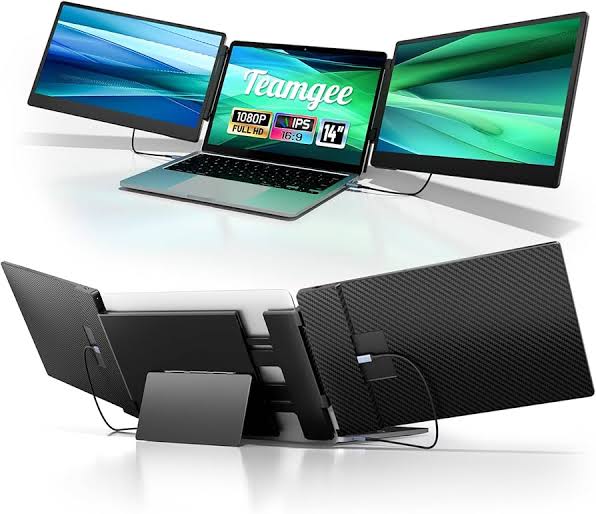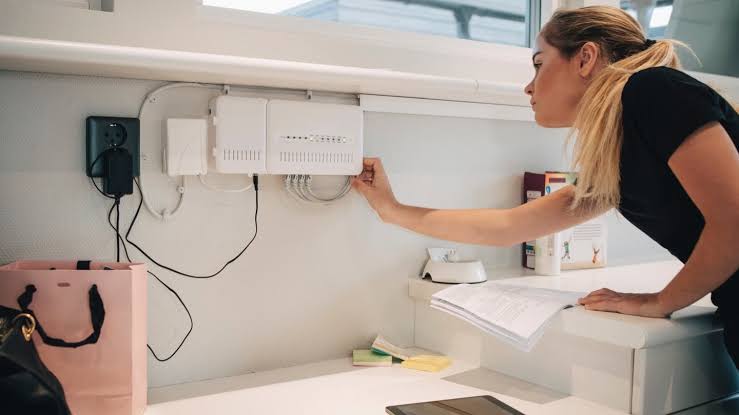The Best Portable Monitors for Remote Workers: In today’s remote work culture, flexibility, mobility, and productivity are key. As more professionals set up home offices, travel frequently, or transition between coworking spaces, the need for dual-screen setups has never been greater. Enter the portable monitor a slim, lightweight screen designed to give you the extra digital real estate you need wherever you go.

Whether you’re a digital nomad, freelance designer, coder, or just someone trying to replicate the efficiency of an office setup from your kitchen table, a portable monitor can be a game-changer.
This guide explores the best portable monitors for remote workers in 2025, including top models, key features to look for, use-case breakdowns.
Why Portable Monitors Matter for Remote Workers
1. Improved Productivity
Multiple studies show that dual monitors can increase productivity by 20–30%. With a second screen, you can:
- View documents while on a video call
- Edit and preview content simultaneously
- Drag-and-drop files easily between programs
2. Flexibility
A portable monitor transforms a single-screen laptop setup into a multi-screen workstation anywhere—be it a café, hotel, or conference room.
3. Enhanced Multitasking
Whether you’re editing spreadsheets, working on a design in Adobe, or running code alongside a debugger, a second screen streamlines your workflow.
Key Features to Consider
Before we jump into the top models, here are essential criteria to consider when buying a portable monitor:
Size and Weight
Portability means lightweight and compact. Most portable monitors range between 13 to 17 inches. For frequent travelers, a 14-inch screen strikes a balance between usability and mobility.
Resolution
Look for at least 1080p (Full HD) resolution. For designers or video editors, 4K options offer better detail and color fidelity.
Connectivity
USB-C is now the standard for portable monitors, offering power and display over one cable. HDMI and mini-HDMI ports are great for broader compatibility with older devices.
Power Source
Monitors can be USB-powered (from your laptop or power bank) or require external adapters. USB-C-powered screens are more portable-friendly.
Display Technology
Choose between IPS panels (great color and viewing angles), OLED (better contrast), or cheaper TN panels (usually found in budget options).
Built-in Features
- Touchscreen capability
- Built-in speakers
- Adjustable stands or kickstands
- VESA mounting compatibility
- Eye care modes (blue light filters)
READ ALSO: How to Choose the Best Antivirus Software for 2025
Top Portable Monitors for Remote Workers (2025 Edition)
1. ASUS ZenScreen MB16ACV
Best for: Business professionals & general users
- Size: 15.6-inch
- Resolution: 1920 x 1080 (Full HD)
- Weight: 1.7 lbs
- Connectivity: USB-C, USB-A (with driver)
- Features: Blue light filter, anti-glare, foldable stand
Pros:
- Lightweight and travel-ready
- Smart case doubles as a stand
- TUV Rheinland-certified eye care
Cons:
- No touchscreen
- Mediocre speakers
2. ViewSonic VG1655
Best for: Remote multitasking and media work
- Size: 15.6-inch
- Resolution: Full HD
- Weight: 1.8 lbs
- Connectivity: USB-C x2, Mini-HDMI
- Features: Built-in speakers, dual USB-C, matte finish
Pros:
- Excellent build quality
- Ultra-thin profile
- Great for side-by-side document viewing
Cons:
- Limited brightness in sunlight
- Audio lacks depth
3. LG Gram +View 16MQ70
Best for: Designers & creatives
- Size: 16-inch
- Resolution: 2560 x 1600 (WQXGA)
- Weight: 1.5 lbs
- Connectivity: USB-C
- Features: 16:10 aspect ratio, sRGB 99% color accuracy
Pros:
- Vibrant display ideal for design work
- Ultra-light and thin
- Great color reproduction
Cons:
- Pricey
- No HDMI input
4. Lepow Z1 Pro
Best for: Budget-conscious professionals
- Size: 15.6-inch
- Resolution: 1080p
- Weight: 1.7 lbs
- Connectivity: USB-C, mini-HDMI
- Features: HDR mode, built-in speakers
Pros:
- Affordable with great value
- Wide device compatibility
- Sleek metal chassis
Cons:
- Slightly lower brightness
- Mediocre viewing angles
5. ARZOPA G1 Game
Best for: Gamers and performance users
- Size: 15.6-inch
- Resolution: Full HD, 144Hz refresh rate
- Weight: 1.4 lbs
- Connectivity: USB-C, HDMI
- Features: Ultra-slim design, gaming mode
Pros:
- High refresh rate great for fast visuals
- Very light and slim
- Compatible with consoles
Cons:
- Not color-accurate for professional editing
- No touchscreen
6. SideTrak Swivel Pro
Best for: Laptop-integrated dual-screen use
- Size: 14-inch
- Resolution: Full HD
- Weight: ~1.7 lbs
- Connectivity: USB-C, USB-A
- Features: Attaches directly to laptops, 270° swivel
Pros:
- Highly portable and attachable
- Ideal for working in tight spaces
- Durable build
Cons:
- Heavier laptops may wobble
- Higher cost for a 14” display
Use-Case Scenarios
For Digital Nomads
Go for lightweight options with USB-C support and strong battery efficiency. The ASUS ZenScreen MB16ACV is a great choice.
For Designers
Color accuracy is key. Choose a high-resolution screen with near-100% sRGB or DCI-P3 coverage, like the LG Gram +View.
For Gamers Who Work Remotely
Look for refresh rate (120Hz or 144Hz). The ARZOPA G1 Game balances work and play beautifully.
For Corporate Professionals
Opt for reliability, a sturdy case, and wide compatibility. ViewSonic VG1655 and SideTrak Swivel Pro both deliver.
FAQs
Do I need drivers or software to use a portable monitor?
Most USB-C portable monitors are plug-and-play. However, some older USB-A models may require drivers, especially on Windows systems.
Can I use a portable monitor with my phone or tablet?
Yes, if your device supports USB-C DisplayPort Alternate Mode (Alt Mode). This is common on newer Android phones, iPads (Pro models), and some tablets.
Can a laptop power a portable monitor on its own?
Many USB-C portable monitors draw power directly from the laptop. However, for extended use or higher brightness settings, an external power source or power bank may be helpful.
What’s the difference between a portable monitor and a tablet?
A portable monitor is not a computing device—it’s just a screen. Tablets have their own OS, apps, and hardware. Monitors are used to extend or mirror your device’s display.
Are portable monitors compatible with MacBooks?
Yes, especially those with USB-C or Thunderbolt 3/4 ports. macOS works well with most USB-C monitors. Check for resolution compatibility (some portable monitors may not support native Mac resolutions perfectly).
Can I use a portable monitor for presentations or meetings?
Absolutely. They are ideal for client demos, slide presentations, or using as a secondary screen in virtual meetings.
How durable are portable monitors for travel?
Most are built to be travel-friendly. However, investing in a protective case or sleeve is recommended to prevent screen damage.
How do I mount or position a portable monitor?
Some come with foldable stands or magnetic covers that double as stands. Others have built-in kickstands or offer VESA mount support for more permanent setups.
Certainly! Here are two additional FAQs to complete your guide:
Can I connect multiple portable monitors to one laptop?
Yes, depending on your laptop’s graphics capability and available ports. Many modern laptops can support dual external displays via USB-C, Thunderbolt, or HDMI. You may need a USB-C hub or docking station to expand your connectivity options.
Are touchscreen portable monitors worth it for remote work?
Touchscreen portable monitors can be valuable for tasks like digital drawing, photo editing, or presentations where direct interaction helps. However, for typical office work (emails, documents, spreadsheets), a touchscreen isn’t essential and may not justify the extra cost unless you specifically need the functionality.


